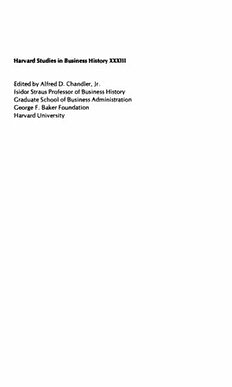
Big Business in China: Sino-Foreign Rivalry in the Cigarette Industry, 1890-1930 PDF
Preview Big Business in China: Sino-Foreign Rivalry in the Cigarette Industry, 1890-1930
Harvard Studies in Business History XXXIII Edited by Alfred D. Chandler, Jr. Isidor Straus Professor of Business History Graduate School of Business Administration George F. Baker Foundation Harvard University Big Business in China Sino-Foreign Rivalry in the Cigarette Industry, 1890-1930 SHERMAN COCHRAN Harvard University Press Cambridge, Massachusetts and London, England 1980 Copyright © 1980 by the President and Fellows of Harvard College All rights reserved Printed in the United States of America Library of Congress Cataloging in Publication Data Cochran,v Sherman, 1940- Big business in China. (Harvard studies in business history; 33) Bibliography: p. Includes index. 1. Cigarette manufacture and trade—China—History. 2. China—Commerce. I. Title. II. Series. HD9149.C42C63 381'.45'679730951 79-23907 ISBN 0-674-07262-6 To fan Editor's Introduction This history of the growth of and the competition between the British- American Tobacco Company and the Nanyang Brothers Tobacco Com pany in China broadens the scope of the Harvard Studies in Business His tory. It is not only the first book in the series on Chinese business history, it is the first on any Asian country. And it is more than just a pioneering study in Asian business history, for it is an outstanding example of com parative business history. In this case the comparison is between the ac tivities of one of the oldest and most successful western multinational enterprises and one of the largest indigenous Chinese firms competing for the same potentially vast market. His comparative approach and his extraordinarily rich source material thus give Professor Cochran's findings a broader relevance than most traditional business histories. The book provides new information on the operations of large industrial enterprises in what remained essentially a preindustrial commercial economy undergoing the initial political and cultural, as well as economic, shocks of early modernization. In addition Cochran provides new information and insights on the ways of duopolis- tic competition. In analyzing the nature and role of entrepreneurship in the Chinese cigarette industry, he helps to resolve the debate over the impact of the absence or presence of entrepreneurial and organization skills on the modernization of the Chinese economy. Further he examines from a new perspective the fundamental issues of imperialistic exploita tion and economic nationalism. His evaluation of these issues casts light on a central problem of economic development—the place of rivalry be tween indigenous enterprises and outside multinationals in the process of growth and modernization. Professor Cochran has demonstrated most successfully how a detailed, thorough study of business records can en large our understanding of institutional and economic change. Alfred D. Chandler, Jr. vii Acknowledgments This book is a study in Chinese business history, a new area of inquiry that will develop into a full-fledged field only if scholars, archivists, busi ness executives, and others are willing to go beyond their usual concerns and give their attention to it. Fortunately for me, many people, from a variety of fields and disciplines, have been willing to take this step. Even when their interests have seemed remote from mine, they have come to my assistance, and I am especially grateful to them. Among Chinese historians, there are four to whom my debt is greatest: Arthur and Mary Wright, whose graduate seminars stimulated my inter est in the history of Sino-foreign interaction; Jonathan Spence, who guided my work on this'topic from the beginning, generously sharing his insights and encouraging me at every stage; and Andrew Hsieh, who introduced me to sources and bibliography and showed me how to search. Other Chinese historians, Beatrice Bartlett, Knight Biggerstaff, Lloyd Eastman, Robert Kapp, Lillian Li, Susan Naquin, and Charles Peterson, read all or parts of this book in manuscript form and saved me from errors of fact and interpretation. Among scholars in other fields who advised me, several also read all or parts of this book and made useful suggestions for improving it: histo rians of American foreign relations Michael Hunt and Walter LaFeber; economists Peter McClelland and Thomas Rawski; and historians of American business Alfred Chandler and Mira Wilkins. Among those -I consulted about business records, two people were especially helpful: Parker Po-fei Huang, who answered my questions about nuances in Chinese business records; and Mattie Russell, who wel comed me to the Manuscript Department, Perkins Library, Duke Univer sity, and gave me access to unpublished papers there. Among those I contacted within the cigarette industry, several granted X Acknowledgments me extensive interviews about their, experiences in China: Y. L. Kan (Chien Jih-lin) of the Nanyang Brothers Tobacco Company; C. C. Kwong (Kuang Ch'ao-ch'i) formerly of the Nanyang Brothers Tobacco Company; Dorothy Quincy Thomas, widow of James A. Thomas of the British-American Tobacco Company; and John Ephgrave, Brian Heam- shaw, and Brian Pearson of the British-American Tobacco Company. I wish to thank all of these people and many others for reaching be yond their immediate concerns, taking an interest in Chinese business history, and helping me. Aboveáll, my thanks go to my wife, Jan, who has worked tirelessly on this book, and, in her tough-minded and loving way, has convinced me to do my part.
